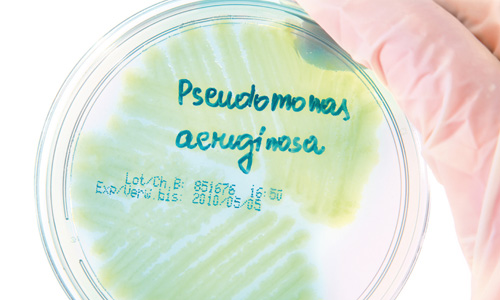Magazine
What are pseudomonads?
Pseudomonads are rod-shaped, non-spore-forming, Gram-negative bacteria with polar flagellae. The best-known member of the genus is Pseudomonas aeruginosa. This bacterium was discovered in 1900. Its high resistance to antibiotics makes it one of the most dangerous hospital-associated pathogens.
Pseudomonads need oxygen for their energy metabolism but are also able to respire using nitrates. They can be found everywhere in the environment and often live on dead organic material. They are very adaptable and their nutrient needs are small. They are to be found in soils and water, on plants and animals, and in other habitats. They can act as opportunistic disease-causing organisms in plants and animals that are already weakened, but not all pseudomonads are pathogenic; some also help to protect plants.

Pseudomonas aeruginosa – a pathogen that is also dangerous to humans
When pseudomonads are under discussion, Pseudomonas aeruginosa is often mentioned at the same time. This bacterium causes many infections in humans and is highly resistant to antibiotics when it is embedded in a biofilm. The symptoms depend on the site of the infection within the body. It also has other effects, such as causing foods to decay. The bacterium itself can even survive and grow in distilled water or in some disinfectants as long as traces of organic substances are present. Pseudomonas aeruginosa can cause severe pneumonia and blood poisoning. The bacterium is also associated with other diseases including urinary tract infections, middle ear infections, wound infections and heart valve infections. In Germany, this pathogen is responsible for 10 % of all nosocomial infections. It is estimated that nosocomial infections with antibiotic-resistant pathogens cause 25,000 deaths per year in Europe.1
Who is at risk?
People who have already been weakened by other diseases are at especially high risk of succumbing to an infection triggered by pseudomonads. The at-risk groups include people with diabetes or cystic fibrosis and also people who are immunocompromised as a result of HIV infection. In addition, immunosuppressed patients (after organ transplants, or cancer patients) should not be allowed to come into contact with these bacteria if at all possible. In general it can be said that hospital patients are at risk because most of them – at least during their hospital stay – have weakened immune systems.
How are the bacteria transmitted?
The bacteria prefer damp areas such as washbasins, toilets, swimming pools without enough chlorine and hot pipes; they also favour disinfectant solutions that are out-of-date or neutralised. Pseudomonas aeruginosa can be present in drinking water. They can also be transmitted on medical devices such as catheters and ventilation equipment. Implants present an additional risk because biofilms containing bacteria can form on their surfaces. In hospitals the pathogen can also be transmitted by the nursing staff.
People who have already been weakened by other diseases are at especially high risk of succumbing to an infection triggered by pseudomonads.
Halting transmission
Different surveys²,³ have shown that the prevalence of nosocomial infections has declined in recent years. This is due to various measures including improvements in hospital hygiene. The importance of water from the building's water system as a source of infection is now well documented. Using point-of-use or inline filters is an effective prevention strategy that can lead to marked reductions in the rate of Pseudomonas aeruginosa infections in hospitals. However, a hygiene plan should also include chemical and thermal disinfection measures. In medical establishments, high quality standards are ensured by testing the water from the building’s water supply for specific pathogens at least every six months. Close contact between hospitals and the relevant water providers is also important, for example when more pathogens occur in the water after heavy rainfall.
Because of their powerful antibiotic resistance, Pseudomonads continue to pose a major threat. It is therefore important to push ahead and implement the appropriate hygiene measures everywhere.
1ecdc.europa.eu/sites/portal/files/media/en/publications/Publications/0909_TER_The_Bacterial_Challenge_Time_to_React.pdf
2https://www.nrz-hygiene.de/fileadmin/nrz/download/pps2016/PPS_2016_Abschlussbericht_20.07.2017.pdf
3Rüden, Daschner, Schumacher: Nosokomiale Infektionen in Deutschland - Erfassung und Prävention (NIDEP-Studie), Teil 1: Prävalenz nosokomialer Infektionen, Qualitätssicherung in der Krankenhaushygiene; 1995